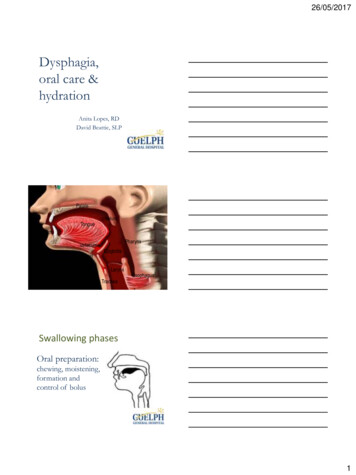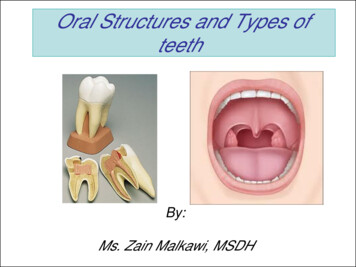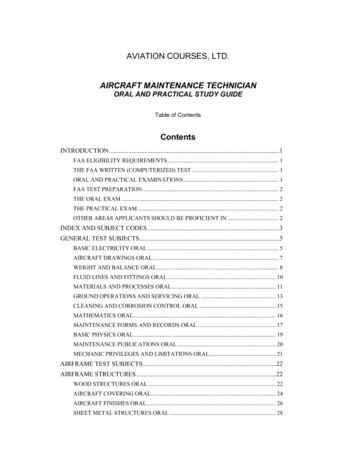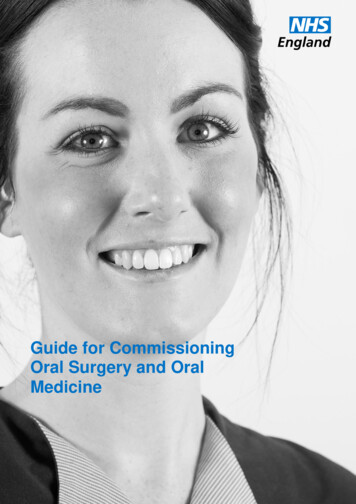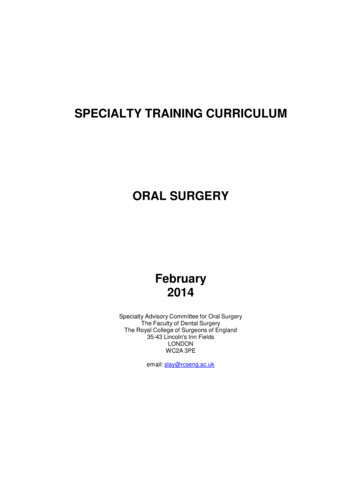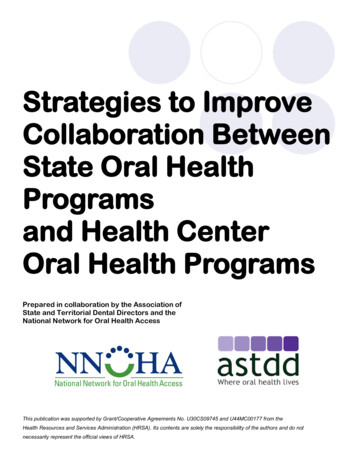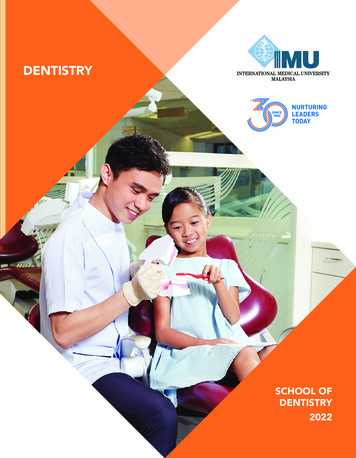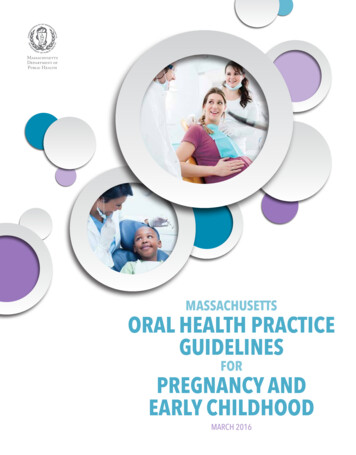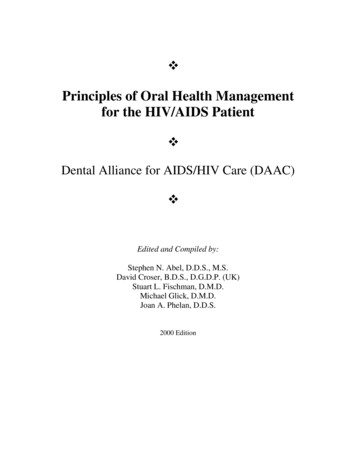
Transcription
vPrinciples of Oral Health Managementfor the HIV/AIDS PatientvDental Alliance for AIDS/HIV Care (DAAC)vEdited and Compiled by:Stephen N. Abel, D.D.S., M.S.David Croser, B.D.S., D.G.D.P. (UK)Stuart L. Fischman, D.M.D.Michael Glick, D.M.D.Joan A. Phelan, D.D.S.2000 Edition
vWorkshop LeadersBarbara Gerbert, Ph.D.Barbara F. Gooch, D.M.D., M.P.HFrancina Lozada-Nur, D.D.S., M.SPatricia A. Murray, D.M.D., Ph.D.Mark M. Schubert, D.D.S., M.S.D.vParticipantsStephen N. Abel, D.D.S., M.S.*Mario Alves, D.D.S., M.S., D.Sc.Helene Bednarsh, R.D.H., M.P.H.Peter Catapano, D.D.S.Denise Cardo, M.D.Roman Carlos, D.D.S.Stephen J. Challacombe, Ph.D., B.D.S.,FRCPath.Gary Chiodo, D.M.D.Jennifer L. Cleveland, D.D.S, M.P.H.Catalina Costa, D.D.S.David Croser, B.D.S., DGDP (UK)Joel Epstein, D.D.S., M.S.Giuseppi Ficarra, M.D.Stuart L. Fischman, D.M.D.Catherine M. Flaitz, D.D.S., M.S.James Formaker, D.D.S.Adi Garfunkel, D.D.S.Michael Glick, D.M.D.*Carolyn F. GrayDeborah Greenspan, B.D.S., D.Sc.*Robert Hale, B.D.S.Bryan Harvey, B.D.SMac Hooton, M.D.Masakazu Ikeda, D.D.S., Ph.D.Peter Jacobson, Ph.D., D.D.S.Daniel Johnson, M.D.Lewis Lampiris, D.D.S., M.P.H.Tadd Lazarus, M.D.Debbie Lewis, B.D.S.Erik Lucht, D.D.S., Ph.D.Cesar A. Migliorati, D.D.S., M.S.Allen Milnes, D.D.S.Enid A. Neidle, Ph.D.Doug Peterson, D.M.D., Ph.D.Joan A. Phelan, D.D.S.*Jens S. Pinborg, Dr. Odont.*Velia Ramirez-Amador, D.D.S., M.Sc.,Ph.D.Francisco J. Ramos-Gomez, D.D.S.,M.Sc., M.P.HDavid A. Reznik, D.D.S.Vincent C. Rogers, D.D.S., M.P.H.James S. Rundle, D.D.S.James J. Sciubba, D.M.D., Ph.D.*Carolyn A. Tylenda, M.S., D.M.D., Ph.D.Isaac van der Waal, D.D.S., Ph.DFariba Younai , D.D.S.*Indicates participants at largeNote: Participants’ affiliations noted in chapter headings reflect positions held during the development ofthis document and may no longer be current.
ContentsAcknowledgementsIntroductionChapter 1 Setting for Obtaining a Health HistoryElements of a Health HistoryChapter 2. 3.23.33.12Management and Evaluation of Occupational Exposures to BloodbornePathogens and TuberculosisManagement of Occupational Exposures to Bloodborne PathogensConsideration of Post-Exposure Management Issues in Dental Settings- Policy StatementPHS Recommendations for Management of Exposure to BloodCDC RecommendationsPost-Exposure OSHA Requirements for Evaluation and Follow UpChapter 52.22.32.42.52.52.72.102.132.142.152.17Oral Manifestations of HIV Infection:Clinical characteristics, diagnosis and treatment recommendationsPrinciples of DiagnosisInfectious LesionsTherapy For HIV Associated Oral LesionsChapter 41.21.3Special Considerations for Dental Patients with HIV/AIDSGeneral Treatment Planning- Stage of Disease Evaluation and Its Implications- Restorative Considerations- Prosthetic ConsiderationsGuidelines For Prevention of Oral DiseasePeriodontal ConsiderationsOral SurgeryEndodontic ConsiderationsOrthodontic ConsiderationsAntimicrobial Prophylaxis and TherapyManagement of the HIV-Infected ChildChapter 3 The Health History and Review of HIV-Related Medically RelevantInformation4.24.74.104.124.19Psychosocial and Ethical Issues Related to Dental Care of Patients withHIV/AIDSSix Basic Principles of Health Care Ethics and Professional Behaviors5.1-5.3
vAcknowledgementsThe Dental Alliance for AIDS/HIV Care (DAAC) wishes to acknowledge funding fromthe Division of Community Based Programs in the HIV/AIDS Bureau, Health Resourcesand Services Administration, U.S. Public Health Service. Additional support wasprovided by the American Dental Association, Academy of Oral Medicine, AIDSEducation and Training Centers, Centers for Disease Control and Prevention (CDC),National Institute of Dental and Craniofacial Research (NIDCR), Pfizer, Inc., LacledeResearch Laboratories, Block Drug Corporation, John O. Butler Company, Johnson &Johnson Dental Division and Ross Laboratories. Special appreciation is extended toBristol Myers-Squibb for continued support for this project.
vIntroductionIn the fall of 1994, at a continuing education conference entitled HIV Disease:Considerations for Dentistry, presented by the Dental Alliance for AIDS/HIV Care(DAAC) and the American Dental Association (ADA), the Principles of DentalManagement of the HIV Infected Patient was initially conceived. The program, held atthe ADA Headquarters in Chicago, brought together for the first time the speakers andexperts who formed the nucleus of dedicated leadership responsible for the production ofthis guide.At that meeting, researchers, educators, clinicians and administrators from the UnitedStates, England, Denmark and the Netherlands recognized the need for clear guidelines toaid the dental professional in the care of the HIV infected patient. Immediately, theybegan working together to create the consensus and document that follow. After monthsof effort and coordination, we are pleased to present these guidelines and to thank themany dedicated professionals for their contributions and support. This document is agroup effort. The participants in each working group contributed expertise to theresulting chapters. The final document could not have come forth without the leadershipprovided by Drs. Gerbert, Gooch, Lozada-Nur, Murray and Schubert. Participants atlarge, Drs. Abel, Glick, Greenspan, Phelan, Pinborg and Sciubba supported the projectthroughout the editing task. (Everyone involved with this project was saddened by thedeath of Dr. Pinborg, whose enthusiasm and vitality encouraged us in the initial phases ofthe development of this guide.) The editors also wish to express special thanks to Dr.Barry Waterman, HIV/AIDS Bureau, HRSA, Linda Crosby of the Talbot RecoveryCenter and Rita May of the Oral Health Education Foundation (OHEF) for all their helpin the creation of these guidelines.In addition to the ADA, a number of other organizations and corporations havecontributed to the development of this publication. These include the Health Resourcesand Services Administration (HRSA), Acadamy of Oral Medicine, AIDS Education andTraining Centees, Centers for Disease Control and Prevention (CDC), National Instituteof Dental and Craniofacial Research (NIDCR), Pfizer, Inc., Laclede ResearchLaboratories, Block Drug Corporation, John O. Butler Company, Johnson & JohnsonDental Division and Ross Laboratories. We wish to express gratitude and appreciation toBristol-Myers Squibb Immunology Division for dedication and support. Additionally,the Ryan White Title III HIV Early Intervention Services Program in the HIV/AIDSBureau significantly supported our efforts. Without support and assistance thispublication would not have been possible.The development of new therapies for management and treatment of HIV infectionhas provided renewed hope for people living with this disease. As people with HIVinfection live longer and healthier lives, comprehensive dental care will become a routine
part of their health care regime. The goal of this publication is to enable the dentalcaregiver to provide appropriate oral health care to these individuals and in this mannercontribute to an improved quality of life for people living with HIV infection and AIDS.This document is a reflection of the best data available at the time of presentationbut remains a work in progress as new therapies and discoveries are made in the area ofHIV/AIDS research. Also, we wish that the reader keep in mind that the data werecompiled from scientific literature after careful conference review. When no documentedevidence existed, recommendations were based on expert opinions. The resultingguidelines are intended as an adjunct rather than a substitute for professional judgementof the individual clinician.The Editors
Chapter 1vThe Health History and Review of HIV-RelatedMedically Relevant InformationvWorkshop Leader:Mark M. Schubert, D.D.S., M.S.D., Fred Hutchinson Cancer Research Center, Seattle,WashingtonParticipants:Adi Garfunkel, D.D.S., Hadassah Hebrew University, Jerusalem, IsraelMac Hooton, M.D., Harborview Medical Center, Seattle, WashingtonPeter Jacobson, Ph.D., D.D.S., University of the Pacific, San Francisco, CaliforniaTadd Lazarus, M.D., New York Medical College, Valhalla, New YorkDoug Peterson, D.M.D., Ph.D., University of Connecticut Health Center, Farmington,ConnecticutDavid A. Reznik, D.D.S., Grady Health System, Atlanta, GAPatients infected with HIV are medically complicated and their health status canchange rapidly, making it especially important that dental professionals obtain a thoroughhealth history. Careful assessment of the patient's health can aid in determination of thepotential influences of HIV disease stage on dental treatment planning. To helpdetermine a patient's stage of HIV disease, as much information as possible should beobtained directly from the patient. Patients are usually well-informed as to their statusand state. Most can reliably report their medications, their last CD4 count, their viral loadand any changes in their overall health. To prepare a complete medical assessment, itmay be necessary to obtain information from the patient's primary care physician.In general, the assessment of the patient's health allows for: a) screening formedical problems, b) assessment of the risks to the patient associated with the provisionof dental treatment and c) evaluation of conditions and diseases that may necessitatemodification of dental treatment. A health history form for assessing any medicallycomplex patient should be adequate for HIV-infected patients. Additional informationspecific to HIV disease may be included. In evaluating the HIV-infected patient,concerns can be generally classified as being related to issues of: a) hemostasis, b)infections, c) drug actions and interactions and d) ability to tolerate dental treatment.Patients may refrain from providing necessary medical information either becausethey are unaware they are ill or at risk of illness or because they do not realize that theirmedical condition may affect dental treatment. As a result, dental health care providers1.1
often must probe for information in order to ensure that all relevant health information isgathered.Prior to requesting any medical information, dentists should obtain a signedconsent from the patient (a consent form that is specific for requesting information onHIV-infected patients is included in Table 1.1). A copy of the signed consent should beplaced in the patient's chart and the original should be sent to the physician. Dentists andtheir staff members should be advised that inappropriate exchange of confidentialmedical information may have significant legal repercussions.Health histories may be obtained orally or on preprinted forms of varying lengthand complexity. The taking of a comprehensive health history reflects a commitment bythe dental professional to be a health care practitioner rather than just a skilled technician.Dentists and hygienists must therefore understand the reason why particular informationis gathered and the treatment implications of the information.This chapter will elaborate on specific HIV related details of medical/healthhistory that need to be assessed and incorporated into dental treatment plans (see Table1.2).vSETTING FOR OBTAINING A HEALTH HISTORYFor all patients, whether HIV-infected or not, the location used for collecting thehealth history can make the difference in whether or not a complete and accurate historyis obtained. Patients will discuss their condition more openly in a private, quiet anddistraction-free environment. Given the intensely personal and emotional aspects andsocial ramifications of HIV infection, the need for privacy is intensified. Health historyforms are best filled out away from general patient areas so that patients are assured ofprivacy.While recognizing the need to discuss the patient’s condition where theconversation cannot be overheard by other patients or other inappropriate persons,dentists should avoid creating the impression of segregation or discrimination throughisolation. If a patient asks why the interview is conducted in a private location, the dentistshould explain that it is an office policy to respect patient confidentiality. A calm,professional and pleasant demeanor is advised when initiating and conducting aninterview.v1.2
ELEMENTS OF A HEALTH HISTORYThis section describes components of the health history that need to be added orexpanded upon when assessing HIV-infected patients. The list of elements to beevaluated are included in Table 1.2 and are discussed below.Date: The date that a health history is initially obtained or when it is updatedmust be clearly indicated. It may be appropriate to complete a separate form atfollow-up appointments to ensure that the latest and most up-to-date informationis obtained.Personal and Demographic Data: Along with the usual identifying informationand registration information it is especially important to obtain the name, address,phone and FAX number for the patient's physician and case manager. Theseindividuals can provide important information about the patient's health that thepatient may not be able to provide.Chief Complaint/History of Chief Complaint: The first interaction between apatient and a dentist involves hearing the patient's chief complaint and the historyof the chief complaint (i.e., the reason the patient is seeking dental care and thehistory of the circumstances that brought the patient to the clinic). Besidesgathering the patient's dental and oral health information, this interaction affordsthe dentist the opportunity to look beyond the patient’s symptoms and illnessesand learn more about the patient as a person, including how the HIV infection andassociated conditions have affected the patient’s life. This tends to help establishtrust and rapport between the dentist and the patient, which encourages honestcommunication. Both the patient and dentist benefit from this relationship.Patients who do not feel comfortable openly discussing these issues with thedentist may withhold information critical to assessment, diagnosis and treatmentdecisions.Past Medical History: As for other patients with complex medical conditions, it isvitally important that the dentist thoroughly review the HIV-infected patient’shealth history, remembering that the patient may also suffer from non-HIVrelated illnesses. In order to obtain complete information, pursuing detailedresponses to questions may be required.Date of Last Visit to Primary Care Physician or Provider: As HIV diseaseprogresses, there is an increasing need to assess, diagnose and treat evolvingconditions. If a patient has not been seen by his or her primary care provider on aregular basis, he or she should be urged to seek follow-up care. Additionally, ifthere is concern that the patient’s medical status is not clearly established,consideration should be given to postponing elective dental procedures until thepatient's status has been appropriately updated.1.3
HIV Test Results: Information should be sought regarding the patient’s history ofHIV testing, including: a) date of first HIV test, b) date of last negative HIV test(if any) and c) date of first positive HIV test. This information will provideperspective about the patient's disease status, expected disease progression anddisease-related complications.Reason for HIV Test: Determining why the patient was initially tested for HIVmay provide important information regarding his or her knowledge and awarenessof HIV disease.Risk Factors for HIV: The manner of HIV transmission is important because ofthe implications for dental and oral complications, which may be more commonamong specific transmission categories (e.g. Kaposi’s sarcoma with homosexualtransmission). Mode of transmission may also have implications for treatment,such as the increased need for antibiotic prophylaxis in individuals with a historyof intravenous drug use, coagulopathies among hemophiliacs or the judicious useof narcotics among substance abusers.HIV Associated Illnesses: Patients should be questioned about diseases associatedwith HIV infection, including malignancies, pneumonias, mycobacterial andcytomegalovirus infections; as well as specific oral problems such as candidiasis,ulcerations, xerostomia and severe and rapidly progressive periodontal disease.CD4 Levels: Dates and values for CD4 levels (first count, lowest count and latestcount) provide perspective about the progression and stage of the disease andindicate the extent of immune system damage already suffered.Viral Load: Plasma HIV RNA levels are obtained because they correlate with themagnitude of viral replication and are associated with the rate of CD4 lymphocytedestruction and thus the rate of disease progression. Changes in viral load inresponse to medications (especially protease inhibitors) should be noted (seeTable 1.3).CBC and Differential (including total white cell, granulocyte, lymphocyte, andneutrophil counts; RBC count and hematocrit; and platelet counts): These countshave obvious implications for a HIV patient's risk for oral and systemiccomplications, most notably infections and bleeding. Recent test results ( 3months) should be obtained.INR: The INR is the current standard for assessing coagulation status.Current Medications (see Table 1.4): HIV infected patients may be taking manymedications with complex dosing regimens. Thus, it is extremely important thatthe patient provides a list of all current medications, including: a) prescriptionmedications, b) self-prescribed (over-the-counter) medications, c) naturopathicand homeopathic remedies and treatments, d) nutritional supplements, and1.4
e) specially imported or foreign drugs. These medications can indicate thepatient's past and present conditions, illnesses and immune status, as well as thepotential for drug reactions and drug interactions. In addition, the dentist willneed an accurate picture of the patient’s drug schedule as this may affect thetiming and length of dental procedures (including duration of local anesthesia).(See appendix III).The list of potential medications HIV-infected patients may be taking can beprodigious. It may be useful to classify them as to a) anti-retrovirals (type andschedule), b) anti-infectives and c) other.Allergies and Drug Sensitivity: Patients with HIV have an increased risk ofallergic and adverse drug reactions as HIV disease progresses. The details ofreactions experienced by patients should be ascertained and recorded when tryingto discern drug allergies from non-allergic drug reactions.Infections:Hepatitis -- HIV-infected patients may be at increased risk of having a numberdifferent types of hepatitis including viral types as well as drug-related hepatitis.Hepatitis, especially if chronic, can alter drug metabolism and increase the risk ofcoagulopathies. It is important to document the type of infection, risk activity,etc.Sexually Transmitted Disease (STD) -- STDs in patients infected with HIV maybe associated with a more rapid progression of HIV disease as well asdeteriorating health from the STD itself (e.g., syphilitic infection may produceneurosyphilis and cardiomyopathy). STD history should be updated regularly toassess patients’ high-risk sexual behavior. As was discussed in Chapter 1, if areasof concern are identified, the dentist should be prepared to either discuss reducingrisk-behavior or refer patients to individuals who can work with the patient in thisarea.Tuberculosis (TB): HIV-infected patients are at increased risk for contracting orreactivating TB. Thus, the TB status of the patient should be determined by thephysician and the dates of TB tests recorded. No elective dental treatment shouldbe provided for patients with active TB. Patients with active disease requiringemergency dental treatment should be referred to facilities capable of managingthese patients. Noncompliance with medical therapy may result in emergence ofresistant strains of Mycobacterium tuberculosis and may also allow the patient toremain infectious to others. Known non-compliance with TB treatment should bereported to public health officials and considered for directly observed therapy(DOT). Appropriate questions to ask the patient include:- When was your last TB skin test?- When was your last chest x-ray?- When was your TB diagnosed?- Have you been prescribed medicine for your TB and, if so, did you follow theinstructions and take the medicine as long as you were told to?1.5
- Have you been told you are noninfectious?- Have you been told you have multiple drug-resistant TB?Tobacco, Alcohol, Recreational Drug Use: Recording the quantity and frequencyof use of these agents is important because of their potential impact on oral andsystemic health and direct provision of dental care, regardless of HIV status.Neurologic Diseases: HIV associated neurologic diseases can significantlyimpact the patients' mental, behavioral and motor activities. Dentists should bealert for cognitive and psychological changes that might not otherwise beexpected in similar non-HIV patients.Medical Consultations and Requests for Additional Information: Afterobtaining and reviewing the health history and medical assessment forms ofthe dental patient with HIV, it may be necessary to communicate with thepatient's primary care provider to confirm or clarify information gathered, torequest an interpretation of findings or to consult about a potential dentaltreatment.Existing Medical Records: For patients with complex or long medicalhistories, it is often useful to request medical records. This can include copiesof hospital charts, clinic records, radiographs, laboratory reports and otherdocumentation. It is important that the request for records include all of therequired identifying information (patient's name, birth date, hospital or clinicidentification number, social security number and so forth). Requests shouldbe clear and concise regarding the type of information needed and over whattime period. Appropriate records to request would include chart notes,pathology reports, laboratory results, etc. Dentists requesting opinions orsummaries from the patient's primary care provider should be sure to makethe circumstances of their request clear (type of dental care proposed, desireto know the risk of complications for a certain treatment, the steps proposedto prevent complications and so forth). Dentists obtaining information overthe phone should be sure to make a clear and complete notation in thepatient's chart. The date, time, person consulted and all informationexchanged should be included in the chart notation.vSUMMARYThis chapter provides recommendations for assessing the medical status of the patientwith HIV, and has reviewed the elements of a thorough health history for patients whoare both HIV-infected and HIV(-). Comprehensive oral health care requires anassessment of the patient's medical status, including progression of HIV disease. A broadspectrum of diseases may present in HIV-infected patients and a number of oral1.6
complications might result. A complete health history that is updated at regular intervals,and supplemented by medical consultation, forms the basis for the provision ofappropriate and optimal dental care.1.7
Table 1.1CONSENT FOR TRANSMITTAL OF HIV-RELATEDINFORMATION*Name and address of person permitted to disclose information:. .Name and address of individual or organization to which the disclosure is to be made:.Name and address of patient:.Purpose of disclosure:.Information to be disclosed:.I, ., hereby give my permission for the above mentioned individualand/or organization/hospital/ clinic/laboratory to disclose pertinent medical records to theindividual/organization listed above.I further understand that I may revoke this consent at anytime. Unless revoked earlier byme, this consent expires .Patient's signature: .Date. .Witness’s signature:.Date.*Practitioners should determine if this sample consent form meets applicable State codes.1.8
Table 1.2HIV Relevant History QuestionnaireDate Personal and demographic data (including other health-care providers) Chief Complaint History of Chief Complaint Past Medical History (including last visit to primary care provider) HIV Test with Dates:first HIV test last negative HIV test first positive HIV test Reason for HIV Test Risk Factor(s) for HIV History of HIV Disease (illnesses, signs and symptoms) CD4 Cell Count with Dates:initial count lowest count latest count Viral Load and Dates:highest rate lowest rate latest rate Complete Blood Cell Count with a Differential Medications with Dosage and Schedules:antiretrovirals anti-infectives other Allergies and Drug Sensitivity Hepatitis (type and status) Sexually Transmitted Diseases (type and status) Tuberculosis (date of test(s) and present status) Tobacco Use (history and present status) Alcohol Use (history and present status) Recreational Drug Use (history and present status) Neurological Diseases 1.9
Table 1.3CD4 CELL COUNT, VIRAL LOAD AND HIV DISEASE PROGRESSION*Cell CountViral loadPercent of patients withmeasurementAIDS-defining complicationsbDNART-PCR3 years6 years9 yearsCD4 350 10001001-60006001-20,00020,001-60,000 60,000 30003001-14,00014,001-41,00041,001-110,000 D4 351-500 10001001-60006001-20,00020,001-60,000 60,000 30003001-14,00014,001-41,00041,001-110,000 4.4CD4-500 10001001-60006001-20,00020,001-60,000 60,000 30003001-14,00014,001-41,00041,001-110,000 370.676.3* Adapted from: Mellors JW, Munoz A, Giorgi JV, et al. Plasma viral load and CD4 lymphocytes asprognostic markers of HIV-1 infection. Ann Intern Med 1997;126:946-9541.10
S ELECTED AGENTS USED TO TREATHIV I NFECTION OR R ELATEDCONDITIONSS ELECTED AGENTS USEDTABLE 1-4TO TREA T HIV I NFECTIONORR ELATED C ONDITIONSAgentDescriptionAdverse EffectsAcyclovir (Zovirax)An antiviral used to treatherpes simplex virus 1 and 2and herpes zoster.Nausea, diarrhea, headache.Abacavir (Ziagen)A nucleoside analogue reverse Hypersensitivity reaction is atranscriptase inhibitor antiserious and potentially fatal sideretroviral agent.effect. Clinical features includefever, skin rash, fatigue, malaise,gastrointestinal (GI) symptoms,arthralgia, cough and/or dyspnea.Abacavir/lamivudine/zidovudine (Trizivir)A combination of threenucleoside analogs.GI upset, anorexia, insomnia, lababnormalities, elevated liverenzymes, mild hyperglycemia,elevated triglycerides, headache,malaise, neuropathy, lactic acidosis, severe hepatomegaly withsteatosis.Amprenavir (Agenerase)A protease inhibitor antiretroviral agent.GI intolerance, rash, headache,oral paresthesias and fatredistribution. Interactions withmany drugs: caution must beused when prescribing in combination with other medications.Atovaquone (Mepron)An antiprotozoal agent used to Rash, nausea, diarrhea, headache.treat Pneumocystis cariniiAdverse oral effect: n antibiotic used to treatchlamydia and bacterialinfections of the skin andrespiratory tract. Used to prevent and treat Mycobacteriumavium complex disease.Nausea, muscle weakness,headache and bone marrow suppression leading to anemia,leukopenia and neutropenia.Cidofovir (Vistide)An antiviral used to treatcytomegalovirusinfection. Given with salineand probenecid to dimish therisk of nephrotoxicity.Nephrotoxicity, neutropenia,metabolic acidosis, uveitis andocular hypotony.1.11
TABLE 1-4SELECTED AGENTS USED TO TREAT HIV I NFECTION OR R ELATED CONDITIONS ( CONT’D.)AgentDescriptionAdverse EffectsCiprofloxacin (Cipro)An antibiotic used to treatmany common bacterial infections. Occasionally used incombination with other drugsto treat Mycobacterium aviumcomplex disease.GI upset, seizure, rash.Clarithromycin (Biaxin)An oral macrolide used to pre- Diarrhea, nausea, abdominal painvent and treat Mycobacterium (at high doses).avium complex disease.Adverse oral effect: Abnormaltaste.Clindamycin (Cleocin)An antibiotic used as an alternative treatment forPneumocystis carinii pneumonia and toxoplasmosis.DapsoneAn antileprotic drug used as an Rash, fever, GI upset.alternative in the treatment andprophylaxis of Pneumocystiscarinii pneumonia.Delavirdine (Rescriptor)A non-nucleoside reverse tran- Rash (which could require drugscriptase inhibitor antiretroviral discontinuation), headaches, andagent.possible increase in transaminases.Didanosine (ddI, Videx)An antiretroviral nucleosideanalogue reverse transcriptaseinhibitor.Pancreatitis, peripheralneuropathy, seizure, diarrhea.Adverse oral effect: )An antineoplastic antibiotic
General Treatment Planning 2.2 - Stage of Disease Evaluation and Its Implications 2.3 . Considerations for Dentistry, presented by the Dental Alliance for AIDS/HIV Care (DAAC) and the American Dental Association (ADA), the Principles of Dental . whose enthusiasm and vitality encouraged us in the initi

